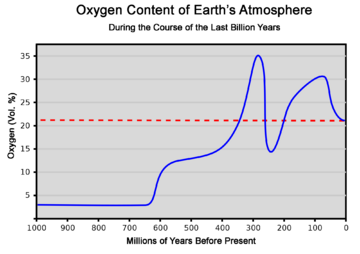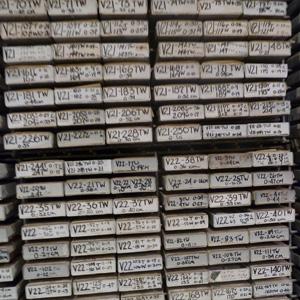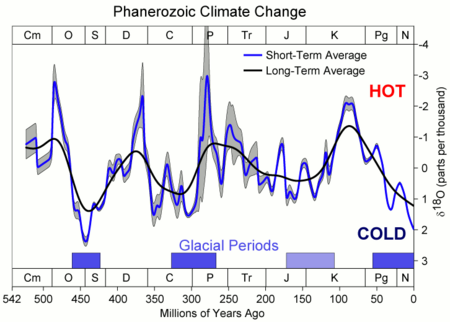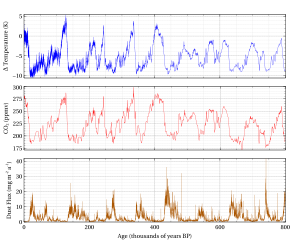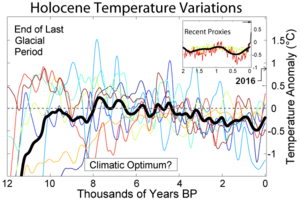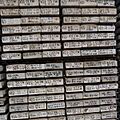Paleoclimatology facts for kids
Paleoclimatology (pronounced pay-lee-oh-kly-mah-TOL-uh-jee) is the study of Earth's past climates. It looks at times when we didn't have tools to measure the weather directly. Since we've only been recording weather for a short time, understanding ancient climates helps us see how Earth's climate naturally changes and how our current climate developed.
Scientists who study paleoclimatology use many clues from nature. They find data preserved in rocks, dirt, ice, tree rings, corals, shells, and tiny fossils. By studying these clues and figuring out their age, they can learn about what Earth's atmosphere was like long ago.
This science became a big field in the 1900s. Paleoclimatologists study important past events like the many ice ages Earth has had, quick cooling times like the Younger Dryas, and fast warming periods like the Paleocene–Eocene Thermal Maximum. Studying past changes in the environment and living things helps us understand today's world, especially how climate affects big extinctions and how life recovers, as well as current global warming.
Contents
How We Study Past Climates
Paleoclimatologists use many different ways to figure out what ancient climates were like. The methods they choose depend on what they want to learn (like temperature or rainfall) and how far back in time they are looking. For example, old ocean floor records, which give us most of our data, only go back about 200 million years because older parts of the ocean floor get pulled back into the Earth. Also, older dirt and rock can be harder to read accurately. The further back in time we go, the less clear and certain our data becomes.
Clues from Nature (Proxies)
Ice Cores: Earth's Frozen Diary
Huge glaciers and polar ice sheets hold a lot of information about past climates. Scientists drill deep into the ice in places like Greenland and Antarctica. They have pulled out ice cores that show us what Earth was like over 800,000 years ago!
- Trapped Air: When snow falls, tiny air bubbles get trapped inside. As more snow piles up, it squeezes into ice, sealing these bubbles. This trapped air is amazing because it lets us directly measure what the air was made of when the ice formed.
- Ice Layers: Just like tree rings, ice forms in layers each year. These layers help scientists count back in time and know how old different parts of the ice core are.
- Layer Thickness: The thickness of these layers can tell us about changes in how much snow fell or how warm it was.
- Oxygen in Ice: The amount of a heavier type of oxygen (Oxygen-18) in ice layers tells us about the average ocean temperature. Water with more Oxygen-18 evaporates when it's warmer.
- Pollen: Scientists find pollen in ice cores. Pollen comes from plants and can tell us which plants were growing when the ice formed. Knowing the plants helps us understand the temperature and rainfall back then.
- Volcanic Ash: Some ice layers contain ash from old volcanic eruptions. Each eruption leaves unique ash. Finding this ash helps scientists pinpoint the exact time a layer formed.
Scientists from many countries, like the European Project for Ice Coring in Antarctica (EPICA), have drilled ice cores that go back 800,000 years. They are now trying to find even older ice, hoping to go back 1.5 million years!
Tree Rings: Nature's Growth Chart
Dendroclimatology is the study of climate using tree rings. Trees grow faster or slower depending on the climate. This change in growth shows up as thicker or thinner rings. Different types of trees react differently to climate changes.
Scientists collect rings from many living trees in an area. They can also use old, well-preserved wood to extend their records back thousands of years. By matching the patterns of thick and thin rings, they can build a long timeline. Older wood that doesn't connect to living trees can be dated using radiocarbon dating. Tree rings can tell us about rainfall, temperature, water levels, and even past fires in an area.
Sediments: Layers of Earth's Past
For even longer periods, geologists look at layers of sediment (dirt and rock).
- Fossils in Sediments: Sediments, which sometimes turn into rock, can hold tiny bits of old plants, animals, or pollen. These clues can tell us what kind of climate existed when the sediment formed.
- Chemical Clues: Certain chemicals in sediments, like the ratio of magnesium to calcium in tiny Foraminifera shells, can help scientists figure out past temperatures.
- Isotopes: Different types of atoms (isotopes) in sediments also give clues. For example, oxygen isotopes tell us about temperature and how much ice was on Earth.
Sedimentary Facies: Over very long times, rock layers can show if sea levels rose or fell. They can even show "fossilized" sand dunes. By studying these sedimentary rocks, which go back billions of years, scientists can understand Earth's long-term climate. The different periods in Earth's history are often based on clear changes in these rock layers, which show big shifts in conditions, including climate.
Coral "Rings": Ocean's Climate Record
Corals also have growth "rings" similar to trees. These rings react to things like water temperature, how much fresh water enters the ocean, and even wave action. Scientists can use special tools to learn about sea surface temperature and saltiness from the past few hundred years. A specific type of red algae that grows on corals can also give clues about ocean temperature and saltiness in cold and tropical areas where other methods don't work as well.
Landforms: Shapes of Past Climates
Studying old landforms, like ancient riverbeds or sand dunes, can help scientists guess what the climate was like long ago. This is part of a field called climatic geomorphology. However, it's not as useful for recent climate changes because those changes don't always leave clear marks on the land.
Dating the Clues
Scientists use a field called geochronology to figure out how old these climate clues are. For recent clues like tree rings and corals, they can simply count the yearly rings to get an exact date.
Radiometric Dating: For older materials, they use radiometric dating. This method looks at radioactive elements in the clues. Over time, these elements decay. By measuring how much they've decayed, scientists can tell how old the material is.
One example is radiocarbon dating. Cosmic rays in the air create a special radioactive carbon (Carbon-14). When plants use carbon to grow, they take in Carbon-14. Once the plant dies, it stops taking in new carbon, and the Carbon-14 starts to decay. By comparing the amount of normal carbon to Carbon-14, scientists can tell how long ago the plant material stopped being connected to the atmosphere.
Big Climate Events in Earth's History
As we go further back in time, our knowledge of exact climate events becomes less clear. But some major events are well-known:
- Huronian Glaciation: Around 2.4 to 2.1 billion years ago, Earth was probably completely covered in ice. This might have happened because of the Great Oxygenation Event, when a lot of oxygen appeared in the atmosphere.
- Snowball Earth: About 600 million years ago, Earth again became a "Snowball Earth" before the Cambrian Explosion, when many new life forms appeared.
- Carboniferous Rainforest Collapse: Around 300 million years ago, huge rainforests collapsed, leading to big changes in climate.
- Permian–Triassic Extinction: About 252 million years ago, the biggest extinction event in Earth's history happened, likely linked to massive climate changes.
- Paleocene–Eocene Thermal Maximum: Around 55 million years ago, Earth experienced a very rapid and extreme warming event.
- Last Glacial Maximum: About 23,000 years ago, ice sheets covered large parts of North America and Europe.
- Younger Dryas: Around 11,000 BCE, there was a sudden, short period of extreme cold.
- Medieval Warm Period: From about 900 to 1300 CE, parts of the Earth were warmer than usual.
- Little Ice Age: From about 1300 to 1800 CE, many parts of the world experienced cooler temperatures and more glaciers.
- Year Without a Summer: In 1816, a huge volcanic eruption caused global cooling, leading to crop failures and famine in many places.
Earth's Atmosphere Through Time
The air around Earth has changed a lot over billions of years.
First Atmosphere: Hydrogen and Simple Gases
Earth's very first atmosphere was probably made of gases from the early solar system, mostly hydrogen. It might also have had simple gases like water vapor, methane, and ammonia, similar to what we see on gas giants like Jupiter. As the sun formed, its strong winds blew away most of these early gases.
Second Atmosphere: Nitrogen and Carbon Dioxide
The next atmosphere formed from gases released by volcanoes and from impacts by huge asteroids. This atmosphere had a lot of nitrogen and carbon dioxide. Much of the carbon dioxide quickly dissolved in water and formed carbonate rocks.
Signs of water-related sediments have been found from as far back as 3.8 billion years ago. Around 3.4 billion years ago, nitrogen became the main gas in this stable "second atmosphere." Life also started to influence the atmosphere very early, with signs of early life forms dating back 3.5 billion years. Even though the early sun was about 30% weaker than today, Earth stayed relatively warm. This is known as the "faint young Sun paradox."
The geological record shows that Earth's surface was mostly warm during its early history, except for one cold ice age about 2.4 billion years ago. In the late Archaean eon, an atmosphere with oxygen began to form. This oxygen came from tiny organisms called cyanobacteria that could do photosynthesis. Fossils of these organisms, called stromatolites, have been found from 2.7 billion years ago. The basic way carbon moved through the Earth system was set up as early as 4 billion years ago.
Third Atmosphere: Oxygen Rises
The constant movement of continents due to plate tectonics affects the atmosphere over long periods. It moves carbon dioxide into and out of large stores of carbonate rocks.
Free oxygen didn't exist in the atmosphere until about 2.4 billion years ago, during the Great Oxygenation Event. Before this, any oxygen made by photosynthesis was used up by other materials, especially iron. Oxygen only started to build up in the atmosphere when the amount of oxygen being made was more than the amount being used up. This changed Earth's atmosphere from one that used up oxygen to one that had oxygen. Oxygen levels changed a lot until they reached more than 15% by the end of the Precambrian time. After this, during the Phanerozoic eon, animals that breathe oxygen began to appear.
The amount of oxygen in the atmosphere has gone up and down over the last 600 million years. It reached a high of 35% during the Carboniferous period, much higher than today's 21%. Two main things control these changes: plants use carbon dioxide and release oxygen, and the breakdown of certain minerals and volcanic eruptions release sulfur, which uses up oxygen. However, volcanoes also release carbon dioxide, which plants can turn into oxygen. We don't know the exact reasons for all the changes in oxygen levels. Periods with lots of oxygen are linked to times when animals developed quickly. Today's atmosphere has 21% oxygen, which is plenty for animals to thrive.
Climate During Earth's Ages
- The Huronian glaciation was the first known ice age, from 2.4 to 2.1 billion years ago.
- The Cryogenian glaciation lasted from 720 to 635 million years ago.
- The Andean-Saharan glaciation was from 450 to 420 million years ago.
- The Karoo glaciation lasted from 360 to 260 million years ago.
- The Quaternary glaciation is the current ice age period, which started 2.58 million years ago.
In 2020, scientists created a detailed record of Earth's climate over the past 66 million years. They found four main climate states, with changes between them involving greenhouse gases and polar ice. The warmest state since the dinosaurs died out, called "Hothouse," lasted from 56 to 47 million years ago and was about 14°C warmer than modern average temperatures.
Precambrian Climate: Early Earth's Big Freezes
The climate in the late Precambrian had some huge ice ages that covered much of the Earth. At this time, the continents were joined together in a supercontinent called Rodinia. Scientists find huge deposits of rock left by glaciers and unusual chemical signs, which led to the "Snowball Earth" idea. As the Proterozoic Eon ended, Earth began to warm up. By the start of the Cambrian period, life forms were everywhere in the "Cambrian explosion", and global temperatures were around 22°C.
Phanerozoic Climate: Life and Changing Temperatures
For millions of years before humans, big climate changes were caused by things like changes in the sun's energy, volcanic ash, how Earth moved around the sun, and how continents shifted. In the early Phanerozoic, more carbon dioxide in the atmosphere was linked to higher global temperatures. Scientists have found that Earth's climate reacted to these changes in a similar way to how it reacts today.
The difference in global average temperatures between a completely ice-covered Earth and an ice-free Earth is about 10°C. However, changes would be much bigger near the poles and smaller near the equator. For large ice sheets to form, continents need to be located at or near the poles. The constant movement of continents also shapes long-term climate. But having land at the poles doesn't always mean there will be ice caps. There's evidence of past warm periods when polar land masses, like Antarctica, had forests instead of ice.
A relatively warm period between the Jurassic and Cretaceous times happened when the supercontinent Pangea broke apart. This led to more volcanic activity from mid-ocean ridges.
On top of these long-term hot and cold climates, there have been many shorter, sudden climate changes. Some of the most severe, like the Paleocene-Eocene Thermal Maximum, might be linked to sudden releases of methane from the oceans.
A similar, sudden climate change after a meteorite impact is thought to be the reason for the Cretaceous–Paleogene extinction event that killed the dinosaurs. Other major extinction events, like the Permian-Triassic and Ordovician-Silurian extinctions, also had various causes, often linked to climate.
Quaternary Climate: Our Current Ice Age Cycle
The Quaternary period is the geological time we are in now. For the past 2.2 to 2.1 million years, Earth has been in a cycle of ice ages.
Look at the graph on the right. You can see strong cycles of about 120,000 years. Notice how the curves are uneven: ice ages get colder in steps, but the warming back to warmer periods happens in one big jump.
The graph on the left shows temperature changes over the last 12,000 years from different sources. The thick black line is an average.
What Drives Climate Change?
Climate forcing is the difference between the sun's energy Earth receives and the heat Earth sends back into space. This is measured in watts per square meter. Depending on this balance, Earth either warms up or cools down. Earth's energy balance changes due to variations in sunlight and the amounts of greenhouse gases and tiny particles called aerosols in the air. Climate change can happen because of processes inside Earth or from outside influences.
Inside Earth: Internal Processes
Earth's climate system includes the atmosphere (air), biosphere (life), cryosphere (ice), hydrosphere (water), and lithosphere (land). All these parts work together to affect the climate. Greenhouse gases act as an internal force on the climate system. Climate scientists are very interested in how sensitive Earth's climate is to all these forces combined.
Examples:
- Ocean Currents: Deep ocean currents (like the Thermohaline circulation) move heat around the globe.
- Life: Living things (the biosphere) change the atmosphere and land.
Outside Influences: External Forces
- Earth's Orbit: The Milankovitch cycles describe how Earth's distance and position to the sun change over long periods. This affects how much sunlight Earth receives.
- Volcanoes: Volcanic eruptions are considered an internal force, but they can have a big impact on climate.
- Human Activities: Changes humans make to the atmosphere (like adding greenhouse gases) or to land use (like cutting down forests).
How It All Works
Over millions of years, the uplift of mountain ranges and the wearing down of rocks (weathering) are important parts of the carbon cycle. Weathering removes carbon dioxide from the atmosphere when minerals react with chemicals. The opposite effect is volcanism, which releases carbon dioxide into the atmosphere, affecting ice age cycles. Scientist James Hansen has suggested that humans are releasing carbon dioxide 10,000 times faster than natural processes have in the past.
The movement of ice sheets and continents (and related changes in plants) have been important for Earth's climate over long periods. There is also a strong link between carbon dioxide and temperature, showing that carbon dioxide has a big control over global temperatures throughout Earth's history.
Images for kids
See also
 In Spanish: Paleoclimatología para niños
In Spanish: Paleoclimatología para niños
- Paleoatmosphere
- Paleoceanography
- Paleothermometer
- Paleohydrology
- Paleotempestology
- Paleomap
- Reducing atmosphere



